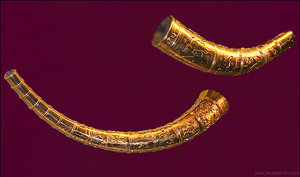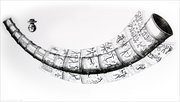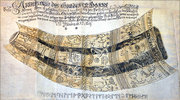
(Modern days replica)
The Golden horns of Gallehus were two golden horns, one shorter than the other, discovered in Denmark. The horns date back to the fourth century (Germanic Iron Age). The horns were made of solid gold and constructed from rings, each covered with figures . These figures depict some actual events or norse saga. One theory is that the illustration comes from Celtic mythology rather than Norse.
The horns are believed to originate with the Angles. The horns have probably been used for ritual drinking. Similar horns of wood, glass, bone and bronze have been found.
Drawing (1641) of the first horn.
The first horn (the long) was 75,8 centimeter, the opening diameter was 10,4 centimeter, and weighed 3,2 kg. This horn was discovered in 1639 by a peasant girl in the village of Gallehus, near Mogeltonder. The first image of the horn was made in 1641.
Drawing (1734) of the second (short) horn and its runic inscription.
About 100 years later in 1734 the other (shorter, damaged) horn was found not far from the first one. From this moment both horns were stored at Christiansborg, currently the Danish national archive.
This second horn has a runic inscription:
ek hlewagastiR holtijaR horna tawido

Step by step translation:
ek hlewa·gast·i·R : holt·ij·aR : horn·a : taw·id·o :
ek
- MHG ich, ME I
hlewa·gast·i·R~z
- hlewa-: cf. Chlodiwg, 'famous'
- -gast-: cf. ME guest, MHG Gast, Lat. hostis
- -i-: stem-formative, cf. Latin i-stems
- -R~z: case & number ending
holt·ij·aR~z
- holt-: name
- -ij-: stem formative
- -aR~z: patronymic = 'son of'
horn·a
- horn-: cf. ME, MHG horn, Lat. cornus
- -a: case & number ending for acc.sg.
taw·id·o
- taw-: verb stem 'work, make'
- -id-: dental suffix = tense marker for preterite 'made'
- -o: person & number inflexion for 1sg 'I made'
Translation:
ek |
hlewagastiR |
holtijaR |
horna |
tawido |
I |
Hlewagast |
son of Holt |
[this] horn |
made |
In 1802 the horns were stolen by a goldsmith and recycled to gold. The copies based on the pictures were created in 1980.

